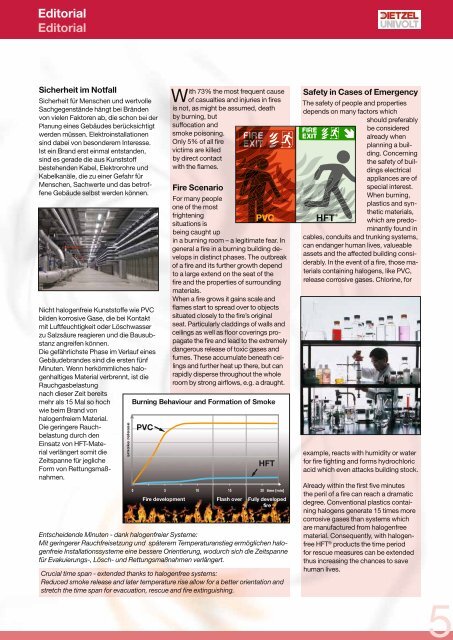Dosen und Kästen Installation Boxes
Dosen und Kästen Installation Boxes
Dosen und Kästen Installation Boxes
Sie wollen auch ein ePaper? Erhöhen Sie die Reichweite Ihrer Titel.
YUMPU macht aus Druck-PDFs automatisch weboptimierte ePaper, die Google liebt.
Editorial<br />
Editorial<br />
Sicherheit im Notfall<br />
Sicherheit für Menschen <strong>und</strong> wertvolle<br />
Sachgegenstände hängt bei Bränden<br />
von vielen Faktoren ab, die schon bei der<br />
Planung eines Gebäudes berücksichtigt<br />
werden müssen. Elektroinstallationen<br />
sind dabei von besonderem Interesse.<br />
Ist ein Brand erst einmal entstanden,<br />
sind es gerade die aus Kunststoff<br />
bestehenden Kabel, Elektrorohre <strong>und</strong><br />
Kabelkanäle, die zu einer Gefahr für<br />
Menschen, Sachwerte <strong>und</strong> das betroffene<br />
Gebäude selbst werden können.<br />
Nicht halogenfreie Kunststoffe wie PVC<br />
bilden korrosive Gase, die bei Kontakt<br />
mit Luftfeuchtigkeit oder Löschwasser<br />
zu Salzsäure reagieren <strong>und</strong> die Bausubstanz<br />
angreifen können.<br />
Die gefährlichste Phase im Verlauf eines<br />
Gebäudebrandes sind die ersten fünf<br />
Minuten. Wenn herkömmliches halogenhaltiges<br />
Material verbrennt, ist die<br />
Rauchgasbelastung<br />
nach dieser Zeit bereits<br />
mehr als 15 Mal so hoch<br />
wie beim Brand von<br />
halogenfreiem Material.<br />
Die geringere Rauch- PVC<br />
belastung durch den<br />
Einsatz von HFT-Material<br />
verlängert somit die<br />
Zeitspanne für jegliche<br />
Form von Rettungsmaßnahmen.<br />
With 73% the most frequent cause<br />
of casualties and injuries in fires<br />
is not, as might be assumed, death<br />
by burning, but<br />
suffocation and<br />
smoke poisoning.<br />
Only 5% of all fire<br />
victims are killed<br />
by direct contact<br />
with the flames.<br />
Fire Scenario<br />
For many people<br />
one of the most<br />
frightening<br />
PVC<br />
situations is<br />
being caught up<br />
in a burning room – a legitimate fear. In<br />
general a fire in a burning building develops<br />
in distinct phases. The outbreak<br />
of a fire and its further growth depend<br />
to a large extend on the seat of the<br />
fire and the properties of surro<strong>und</strong>ing<br />
materials.<br />
When a fire grows it gains scale and<br />
flames start to spread over to objects<br />
situated closely to the fire’s original<br />
seat. Particularly claddings of walls and<br />
ceilings as well as floor coverings propagate<br />
the fire and lead to the extremely<br />
dangerous release of toxic gases and<br />
fumes. These accumulate beneath ceilings<br />
and further heat up there, but can<br />
rapidly disperse throughout the whole<br />
room by strong airflows, e.g. a draught.<br />
HFT<br />
smoke release Burning Behaviour and Formation of Smoke<br />
0 5 10 15 20 time [min]<br />
Fire development Flash over Fully developed<br />
fire<br />
Entscheidende Minuten - dank halogenfreier Systeme:<br />
Mit geringerer Rauchfreisetzung <strong>und</strong> späterem Temperaturanstieg ermöglichen halogenfreie<br />
<strong>Installation</strong>ssysteme eine bessere Orientierung, wodurch sich die Zeitspanne<br />
für Evakuierungs-, Lösch- <strong>und</strong> Rettungsmaßnahmen verlängert.<br />
Crucial time span - extended thanks to halogenfree systems:<br />
Reduced smoke release and later temperature rise allow for a better orientation and<br />
stretch the time span for evacuation, rescue and fire extinguishing.<br />
Safety in Cases of Emergency<br />
The safety of people and properties<br />
depends on many factors which<br />
should preferably<br />
be considered<br />
already when<br />
planning a building.<br />
Concerning<br />
the safety of buildings<br />
electrical<br />
appliances are of<br />
special interest.<br />
When burning,<br />
plastics and syn-<br />
HFT ®<br />
thetic materials,<br />
which are predominantly<br />
fo<strong>und</strong> in<br />
cables, conduits and trunking systems,<br />
can endanger human lives, valueable<br />
assets and the affected building considerably.<br />
In the event of a fire, those materials<br />
containing halogens, like PVC,<br />
release corrosive gases. Chlorine, for<br />
example, reacts with humidity or water<br />
for fire fighting and forms hydrochloric<br />
acid which even attacks building stock.<br />
Already within the first five minutes<br />
the peril of a fire can reach a dramatic<br />
degree. Conventional plastics containing<br />
halogens generate 15 times more<br />
corrosive gases than systems which<br />
are manufactured from halogenfree<br />
material. Consequently, with halogenfree<br />
HFT ® products the time period<br />
for rescue measures can be extended<br />
thus increasing the chances to save<br />
human lives.<br />
5


